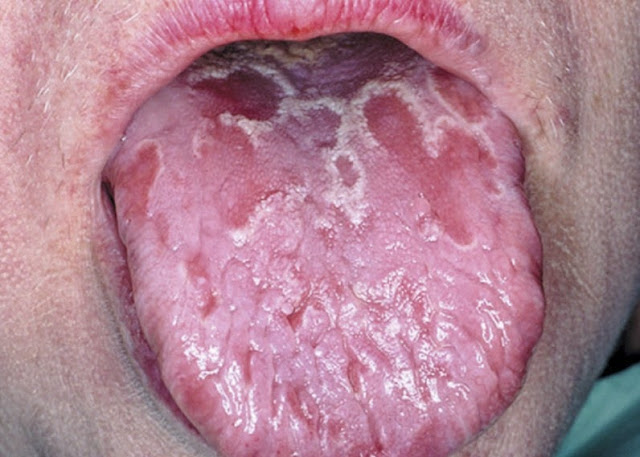Geographic Tongue
Do YOU have 'geographic tongue'? Physicists shed light on bizarre condition that makes the tongue look like a map
- The condition causes a mottled tongue, but no one knows why
- It is not contagious but can be painful and affects 2% of individuals
- New equations have revealed how geographic tongue creates patterns
- Doctors may be able to judge the severity of condition based on patterns
It's a gruesome condition that has long baffled scientists.
Known as geographic tongue (GT), the ailment causes people to have a mottled tongue featuring bizarre designs such as circles and what has been described as a 'map of continents'.
While no one is sure what causes it, physicists have recently discovered there are two types of GT which, combined, affect around two per cent of the population.
Geographic tongue (GT) changes the tongue's upper layer of tissue, called the epithelium, which contains tastebuds.
In people with GT, some of the structures containing these buds become inflamed, according to study co-author Gabriel Seiden, a physicist at the Weizmann Institute of Science.
The condition is not contagious but can be chronic.
The cause is unknown but scientists believe genetics may play a part. Stress, allergies, diabetes and a hormonal imbalance have also been proposed, but scientists have so far been unable to conclusively prove any of these can trigger the condition.
While the tongue does heal itself eventually, the patterns always return and can cause some mild pain.
In the study, researchers used equations that treated GT as an 'excitable medium' through which waves of a certain state could pass through.
It can spread through a forest, but it cannot return to a burnt spot until the vegetation has regrown.
'When this flame grows,' Professor Seiden told Live Science, 'it essentially destroys this layer, and continues until the whole forest is burned down,' or the entire tongue is affected.
In one version of the condition, GT starts out as a series of small spots that expand gradually in a circular pattern.
The patterns cannot form in areas that have already been affected, causing the bizarre shapes.
In a more serious version of GT, spiral patterns develop which can move into parts of the tongue that are still healing.
'We hope these results can be used by physicians as practical way of assessing the severity of the condition based on the characteristic patterns observed,' said Professor Seiden.

Just as the development of forest fires can be affected by external conditions, such as the strength of the wind, the researchers say the conditions surrounding the tongue may also have important consequences for GT.
In their study, they observed a one-year-old boy who developed the characteristic lesions on multiple occasions along the tongue's edge adjacent to growing teeth.
They say this implies the constant rubbing of the tongue against the gum may trigger GT.
'Going forward, we intend to collaborate with physicians and dentists who treat GT patients to obtain valuable - and often scarce - empirical data regarding the dynamic evolution of the condition,' Dr Seiden continued.
WHAT IS GEOGRAPHIC TONGUE?
- Geographic tongue (GT) causes people to have a mottled tongue featuring bizarre designs such as circles and 'continents'.
- It is not contagious but affects around two per cent of the population.
- Scientists are still unsure what causes but some say genetics may be a common link.
- About one in 10 people with geographic tongue may have mild discomfort but the condition is otherwise harmless.
- It occurs when parts of the tongue are missing layers of small bumps known as papilla.
- Doctors often prescribe anti-inflammatories, mouth rinses and zinc supplements to treat the symptoms.
- The condition is chronic and there is no known cure for GT.






Comments
Post a Comment